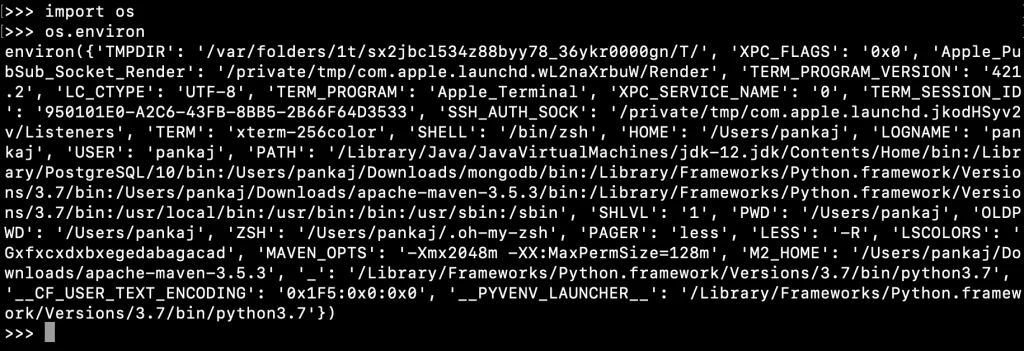Check If Variable Exists Python
Variables play a crucial role in any programming language, including Python. They allow us to store, manipulate, and retrieve data as needed. In certain scenarios, it becomes necessary to check if a variable exists before performing further operations. This article will explore various ways to achieve this in Python. Additionally, we will provide a comprehensive guide to addressing frequently asked questions regarding the topic.
1. Using the “in” keyword with locals() or globals():
One way to check if a variable exists in Python is by using the “in” keyword along with the locals() or globals() functions. The locals() function returns a dictionary containing all local variables, while the globals() function returns a dictionary containing all global variables. By utilizing these functions, you can check if a specific variable is present within the corresponding namespace.
For example:
“`python
variable_name = ‘example’
if variable_name in locals():
print(‘Variable exists’)
“`
or
“`python
variable_name = ‘example’
if variable_name in globals():
print(‘Variable exists’)
“`
2. Utilizing the locals() and globals() functions:
Another approach involves using the locals() and globals() functions together with the built-in “hasattr()” function. This function allows you to determine if an object has a given attribute. By passing the locals() or globals() dictionaries as the first argument and the variable name as the second argument, you can check if a variable exists.
Example:
“`python
variable_name = ‘example’
if hasattr(locals(), ‘variable_name’):
print(‘Variable exists’)
“`
or
“`python
variable_name = ‘example’
if hasattr(globals(), ‘variable_name’):
print(‘Variable exists’)
“`
3. The try-except approach:
Using a try-except block is a common and robust method for checking variable existence in Python. By attempting to access the variable and handling a specific exception, you can determine if the variable exists.
Example:
“`python
try:
variable_name
print(‘Variable exists’)
except NameError:
print(‘Variable does not exist’)
“`
4. Employing the hasattr() function:
Similar to the previous approaches, the hasattr() function can be used to check if a variable exists. However, in this case, the function is directly applied to the variable itself.
Example:
“`python
variable_name = ‘example’
if hasattr(variable_name, ‘__call__’):
print(‘Variable exists’)
“`
5. Utilizing the type() function:
The type() function in Python allows you to determine the type of an object. By checking the type of a variable, you can indirectly verify its existence. If the variable does not exist, a `NameError` will be raised.
Example:
“`python
try:
variable_name = ‘example’
print(‘Variable exists’)
except NameError:
print(‘Variable does not exist’)
“`
6. Implementing the inspect module:
The inspect module in Python provides several functions for checking variables. The `getmembers()` function, in particular, can be employed to retrieve all members of a module, class, or any other object. By using this function, you can check if a variable is present.
Example:
“`python
import inspect
variable_name = ‘example’
if variable_name in [name for name, _ in inspect.getmembers(module)]:
print(‘Variable exists’)
“`
7. The dir() function for variable existence checks:
The dir() function returns a list of names in the current local scope. By checking if a variable is included in this list, you can determine its existence.
Example:
“`python
variable_name = ‘example’
if variable_name in dir():
print(‘Variable exists’)
“`
8. The “if” statement for variable existence checks:
Lastly, you can utilize the “if” statement along with the locals() or globals() functions to check if a variable exists. By comparing the variable with None, you can assess its existence.
Example:
“`python
variable_name = ‘example’
if variable_name is not None:
print(‘Variable exists’)
“`
FAQs:
Q: How to check if an environment variable exists in Python?
A: To check if an environment variable exists in Python, you can utilize the `os.environ` dictionary. By checking if the desired variable name is present in this dictionary, you can determine its existence.
Example:
“`python
import os
if ‘VARIABLE_NAME’ in os.environ:
print(‘Environment variable exists’)
“`
Q: How to check if a variable is empty in Python?
A: To check if a variable is empty, you can use the `bool()` function. If the result is `True`, the variable is considered empty. Additionally, you can check if the variable is None or use the `len()` function for sequences like lists or strings.
Example:
“`python
variable_name = ”
if bool(variable_name):
print(‘Variable is not empty’)
else:
print(‘Variable is empty’)
“`
Q: What if my variable is unbound and doesn’t exist?
A: If the variable is unbound and doesn’t exist, a `NameError` will be raised when attempting to access it. You can handle this exception using a try-except block to account for such scenarios.
Q: How to check if a list contains a specific value in Python?
A: To check if a list contains a specific value, you can use the `in` keyword. If the value is present in the list, the result will be `True`.
Example:
“`python
my_list = [1, 2, 3, 4, 5]
if 3 in my_list:
print(‘Value exists in the list’)
“`
Q: How to check if a file exists in Python?
A: To check if a file exists, you can use the `os.path.exists()` function. It takes the file path as an argument and returns `True` if the file exists.
Example:
“`python
import os
if os.path.exists(‘file.txt’):
print(‘File exists’)
“`
Q: How to check if a path exists in Python?
A: Similar to checking file existence, you can use the `os.path.exists()` function to check if a path exists in Python. By passing the path as an argument, you can determine its existence.
Example:
“`python
import os
if os.path.exists(‘/path/to/directory’):
print(‘Path exists’)
“`
In conclusion, checking if a variable exists in Python can be accomplished using various approaches. By applying these techniques, you can write more robust and error-free code, ensuring the proper handling of variables. Whether you prefer the simplicity of the “in” keyword or the versatility of the inspect module, these methods will greatly enhance your programming experience. So, no matter the complexity of your code, verifying variable existence is made simple with Python.
How To Check If A Variable Exists In Python
Keywords searched by users: check if variable exists python Python check environment variable exists, If variable is empty Python, Exist python variable, Python check if variable unbound, Check if list contains value Python, Check exist file Python, Check path exists Python, If not exist python
Categories: Top 58 Check If Variable Exists Python
See more here: nhanvietluanvan.com
Python Check Environment Variable Exists
Python is a popular, high-level programming language that is known for its simplicity and ease of use. It allows developers to accomplish a wide range of tasks, from web development to scientific computing, with its vast array of libraries and frameworks. One essential feature that Python provides is the ability to access and manipulate environment variables. In this article, we will explore how to check if an environment variable exists in Python and how to use this information in your programs.
What is an Environment Variable?
Before diving into the technical details, let’s briefly understand what environment variables are. An environment variable is a dynamic value that can affect the behavior of software or operating systems. It provides a convenient way to store configuration settings or information that can be accessed by various programs running on the same system.
Environment variables are typically set by the operating system or by the software itself during installation. Common examples of environment variables include PATH (which specifies the directories where executable programs are located) and HOME (which stores the user’s home directory).
Checking if an Environment Variable Exists
To determine if an environment variable exists in Python, we can use the `os` module, which provides a set of functions for interacting with the operating system. Specifically, `os.environ` is a dictionary-like object that contains all the environment variables, with their names as keys and their values as corresponding values.
Here’s a simple code snippet that demonstrates how to check if a specific environment variable exists:
“`python
import os
variable_name = ‘MY_ENV_VARIABLE’
if variable_name in os.environ:
print(f”The environment variable {variable_name} exists.”)
else:
print(f”The environment variable {variable_name} does not exist.”)
“`
In the above code, we import the `os` module and specify the name of the environment variable we want to check in the `variable_name` variable. We then use the `in` operator to check if the variable_name exists in the `os.environ` dictionary. If it does, we print a message indicating its existence; otherwise, we print a message indicating its absence.
Handling Missing Environment Variables
When working with environment variables, it is crucial to handle cases where the variable might not exist. To prevent potential errors or unexpected behavior, we can utilize Python’s exception handling mechanism.
“`python
import os
variable_name = ‘MY_ENV_VARIABLE’
try:
env_value = os.environ[variable_name]
print(f”The value of {variable_name} is {env_value}.”)
except KeyError:
print(f”The environment variable {variable_name} does not exist.”)
“`
In this code snippet, we attempt to access the value of the environment variable directly using the `os.environ` dictionary. If the variable exists, we print its value. However, if it does not exist, a `KeyError` will be raised, indicating that the specified key does not exist in the dictionary. We can catch this exception using a `try-except` block and print an appropriate message.
Using Default Values
In many cases, it might be desirable to provide a default value for an environment variable if it is not present. This can be easily achieved using the `get()` method of the `os.environ` dictionary:
“`python
import os
variable_name = ‘MY_ENV_VARIABLE’
default_value = ‘default’
env_value = os.environ.get(variable_name, default_value)
print(f”The value of {variable_name} is {env_value}.”)
“`
In this example, we use the `get()` method to retrieve the value of the environment variable. If the variable is present, its value will be returned. Otherwise, the default value specified in the `default_value` variable will be returned.
FAQs
Q: Can I modify environment variables using Python?
A: Yes, Python provides methods in the `os` module to modify environment variables. You can use `os.environ[‘VARIABLE_NAME’] = ‘new value’` to set a new value for an existing environment variable or create a new variable.
Q: Can I remove an environment variable?
A: Yes, you can use `del os.environ[‘VARIABLE_NAME’]` to remove an environment variable.
Q: Are there any limitations to environment variables in Python?
A: While environment variables are a convenient way to store configuration settings, it’s important to note that they are typically limited to storing simple string values. Additionally, environment variables are specific to the process and are not shared across different Python instances.
Q: How do I list all environment variables?
A: You can print all the environment variables and their values using `print(os.environ)`.
Q: Can I check if an environment variable exists in a case-insensitive manner?
A: By default, the dictionary-like object `os.environ` is case-sensitive. However, you can convert the variable names to lowercase (or uppercase) while checking for their existence to achieve a case-insensitive check.
Conclusion
Checking if an environment variable exists in Python is a straightforward task when utilizing the `os` module. By leveraging the `os.environ` dictionary and appropriate code logic, developers can handle missing variables, use default values, and modify environment variables as needed. Understanding how to work with environment variables is crucial for creating robust and flexible Python programs that can adapt to various system configurations.
If Variable Is Empty Python
In programming, variables are used to store values that can be accessed and manipulated during the execution of a program. However, there are instances when a variable may not have a value assigned to it, resulting in an “empty” variable. In Python, it is important to be able to determine whether a variable is empty or not, as it can affect the flow and logic of the program. In this article, we will explore various methods to check if a variable is empty in Python and discuss some frequently asked questions related to this topic.
There are different ways to determine if a variable is empty or not in Python, depending on the data type of the variable. Let’s explore some commonly used methods:
1. Checking for an empty string:
The most common data type that often requires checking for emptiness is a string. To determine if a string variable is empty, you can use the len() function, which returns the length of the string. If the length of the string is zero, it means the variable is empty.
Example:
“`
my_string = “”
if len(my_string) == 0:
print(“The string is empty”)
“`
2. Checking for an empty list:
Lists are another popular data type in Python. To check if a list variable is empty, you can use the same len() function as with strings. If the length of the list is zero, it means the list is empty.
Example:
“`
my_list = []
if len(my_list) == 0:
print(“The list is empty”)
“`
3. Checking for an empty dictionary:
Dictionaries, also known as associative arrays or mappings, are used to store key-value pairs. To check if a dictionary variable is empty, you can use the bool() function, which returns True if the dictionary is empty and False otherwise.
Example:
“`
my_dict = {}
if bool(my_dict):
print(“The dictionary is not empty”)
else:
print(“The dictionary is empty”)
“`
4. Checking for an empty tuple:
Tuples in Python are immutable sequences, similar to lists. To determine if a tuple variable is empty, you can again use the len() function. If the length of the tuple is equal to zero, it means the tuple is empty.
Example:
“`
my_tuple = ()
if len(my_tuple) == 0:
print(“The tuple is empty”)
“`
5. Checking for an empty set:
Sets are unordered collections of unique elements. To check if a set variable is empty, you can use the len() function just like with strings, lists, and tuples. If the length of the set is zero, it means the set is empty.
Example:
“`
my_set = set()
if len(my_set) == 0:
print(“The set is empty”)
“`
6. Checking for an empty file:
In Python, you can also check if a file is empty using the os.path.getsize() function, which returns the size of a file in bytes. If the size of the file is zero, it means the file is empty.
Example:
“`
import os
file_path = “example.txt”
if os.path.getsize(file_path) == 0:
print(“The file is empty”)
“`
These methods provide a straightforward way to check if a variable is empty in Python based on its data type. However, there might still be some questions or concerns regarding this topic. Let’s address some common FAQs related to checking if a variable is empty in Python.
FAQs:
Q: What happens if I try to access or manipulate an empty variable?
A: If you try to access or manipulate an empty variable, it may result in errors or unexpected behavior. For example, trying to access elements of an empty list or dictionary can raise an index or key error. It’s always a good practice to check if a variable is empty to handle such scenarios gracefully.
Q: Can I use the not operator to check if a variable is empty?
A: Yes, you can use the not operator to check for emptiness, especially with strings, lists, tuples, and sets. For example, `if not my_string` or `if not my_list` will evaluate to True if the variables are empty. However, this approach does not work for dictionaries or files.
Q: How can I check if a variable is not empty?
A: You can use the same methods mentioned above but with a slight modification. For example, instead of checking `if len(my_string) == 0`, you can use `if len(my_string) > 0` or `if my_string`. It ensures that the variable has some value assigned to it.
Q: Can I use try-except blocks to handle empty variables?
A: While try-except blocks can be used to handle exceptions, it’s better to check if a variable is empty explicitly rather than relying on exceptions. It helps improve code clarity and maintainability.
Q: Are there any other methods to check for emptiness?
A: Yes, there are several other methods to check for emptiness, such as comparing the variable to an empty instance of its data type (`if my_string == “”` or `if my_list == []`) or using the `is` operator (`if my_string is “”` or `if my_list is []`). However, these methods may not always be recommended or preferred.
In conclusion, checking if a variable is empty is an important aspect of Python programming. By using the appropriate methods for each data type, you can ensure that your program behaves as expected and handle empty variables effectively. Remember to consider the potential errors and exceptions that can occur when dealing with empty variables to write robust and reliable code.
Images related to the topic check if variable exists python

Found 6 images related to check if variable exists python theme








































Article link: check if variable exists python.
Learn more about the topic check if variable exists python.
- How do I check if a variable exists? – Stack Overflow
- How to check if a Python variable exists? – GeeksforGeeks
- How to Check if a Variable Exists in Python – Studytonight
- How do I check if a Python variable exists – Tutorialspoint
- Testing if a Variable Is Defined – Python Cookbook [Book]
- 3 Easy Ways to Check If Variable Exists in Python – AppDividend
- How do I check if a variable exists in Python? – Gitnux Blog
- How to check whether a variable exists in Python – Reactgo
- 【How to】 Check if the Variable Exists in Python
- How to check if a variable exists in Python – Renan Moura